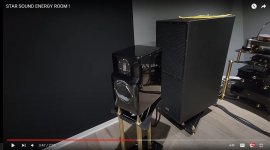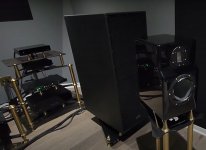Leaks are of course the joker. The building regulations around here prescribe that new building are air tight and gets tested with pressure. However, there can of course be leaky doors and ventilation that equalises the pressure between rooms
A new to me interesting (and nicely polished) example of a Purifi equipped monitor, the Star Sound Technologies Caravelle Mk II.
 .
.
The pics are screen captures from a system tour video on YouTube.
STAR SOUND ENERGY ROOM !
The description of the Caravelle Mk II starts here:
Some other bits in the system:
Amps https://asraudio.de/
DAC https://www.dangerousmusic.com/product/convert-2
Subs http://www.mccauleysound.com/product_overview.cfm?ID=2338
The pics are screen captures from a system tour video on YouTube.
STAR SOUND ENERGY ROOM !
The description of the Caravelle Mk II starts here:
Some other bits in the system:
Amps https://asraudio.de/
DAC https://www.dangerousmusic.com/product/convert-2
Subs http://www.mccauleysound.com/product_overview.cfm?ID=2338
Attachments
Yep - learned this the hard way.It's not a good idea to use a reflex box that is larger than it needs to be. What a lot of people notice is that tuning and box size can be controlled separately to the driver, and they get greedy in their expectation of bass extension, but not always to good effect.
Luckily this is easily obtained by adding sim series resistance to the driver which increases Qes and thereby also Qts
This is interesting, perhaps why I often get slightly different tuning (not much, a couple Hz max, no stuffing) when selecting box and vent sizes. Not taking into account the changing of woofer T/S params. when selecting enclosures and vents. (Also leaks are a factor, but IMO you only get leaky boxes if you cut with skill saws). The differences are only slight and doesn't derail the designs mind you. Quick googling I didn't find much but it makes sense, and is easily observable with VCAD by selecting your crossover when using the enclosure tool. Look forward to your blog on this.
a chimney is a port venting the box (room). Sounds nice eh?especially for those of us with a chimney in the room...
Reminiscent of Pimp my ride “Yo dog we heard you like subwoofers so we turned your entire room into a subwoofer and put subwoofers in there so when your subwoofers hit you’re literally inside a subwoofer Dogg”
Least of the problems the room has mind. Although I have wondered if I could stick a pseudo IB SUB in there for the summers when the fire is not in use...
Hi, I have a 4 purifiptt6.5x08nfa01 drivers. I am considering a sealed dual opposed woofer which works 40-250 hz. What is the general rule for dos project apart from cabinet volume
Probably not a good idea to have anything over 100 hz fire from rear or side depending on what you were thinking?Hi, I have a 4 purifiptt6.5x08nfa01 drivers. I am considering a sealed dual opposed woofer which works 40-250 hz. What is the general rule for dos project apart from cabinet volume
250hz wavelenght is 1.4m long and as long as drivers are no more than quarter wavelenght apart ( about 35cm) their output combine as one. If your enclosure width and depth are max 35cm this happens no matter which side the woofers are, sound radiates about omni (this is below bafflestep). You could have any height on the box as long as drivers are at same plane, which they probably are as you want to have the force cancelling setup.
One can calculate it the otherway around as well. If you already have a box and drivers are 50cm apart you could cross it at 200cm wavelenght, roughly 170Hz or below. 100Hz crossover would allow roughly 85cm spacing, or actually it wouldn't matter much since typical domestic rooms will already dominate the response at this low frequency.
One can calculate it the otherway around as well. If you already have a box and drivers are 50cm apart you could cross it at 200cm wavelenght, roughly 170Hz or below. 100Hz crossover would allow roughly 85cm spacing, or actually it wouldn't matter much since typical domestic rooms will already dominate the response at this low frequency.
IME dual opposed is really only advantageous for large and heavy drivers in relatively light cabinets.
It’s a neat feature to have with minimally vibrating cabinets, but at the particular frequency and SPL that set vibrations of the cabinet going in an offensive way, well before you get there the contents of the room are going to cause more audible and offensive noises.
It’s a neat feature to have with minimally vibrating cabinets, but at the particular frequency and SPL that set vibrations of the cabinet going in an offensive way, well before you get there the contents of the room are going to cause more audible and offensive noises.
When using Purifi woofers I would strongly disagree with this statement. Half the fun with Purifi equipped systems is cranking it up and a single PTT6.5 at 90dB+ puts quite an impressive amount or reaction energy into the cabinet.IME dual opposed is really only advantageous for large and heavy drivers in relatively light cabinets.
It’s a neat feature to have with minimally vibrating cabinets, but at the particular frequency and SPL that set vibrations of the cabinet going in an offensive way, well before you get there the contents of the room are going to cause more audible and offensive noises.
When I read okankav's proposal above I presumed he intended one to fire forward and its mate to the rear. I have spent so many blissful hours listening to ESLs and Magnepans radiating sound front + rear did not strike me as odd.What’s the point of having woofers fire to the sides at 250 hz?
There might be a point or not, sometimes it just doesn't matter.What’s the point of having woofers fire to the sides at 250 hz?
Speakers radiate sound to all directions, and when wavelenght is about four times the dimension of the baffle (simplified) it really doesn't matter on which side the driver is at, sound just goes around the cabinet like it wasn't there at all. As frequency goes up, wavelenght gets shorter and the structure starts to be acoustically large, make shadow to the back, edges diffract and so on, response varies to all directions and per wavelenght. Now there is a lot of concern where the transducers are and what size they are and what kind of structure it is in general and how to manage it all the sound to be good.
So yeah, one could put bass woofers to sides without much consequense as long as the structure is acoustically small. If there is no consequence one might just exploit the situation, why not. For example the baffle could now be made smaller to help reduce diffraction or for aesthetics. We got some of the vibration cancellation, already mentioned. I don't know why woofers are on the front, it is easier and cheaper to manufacture perhaps, or just a convention.
Last edited:
Yes, I am planning to use forward and rearWhen I read okankav's proposal above I presumed he intended one to fire forward and its mate to the rear. I have spent so many blissful hours listening to ESLs and Magnepans radiating sound front + rear did not strike me as odd.
- Home
- Loudspeakers
- Multi-Way
- Exploring Purifi Woofer Speaker Builds

